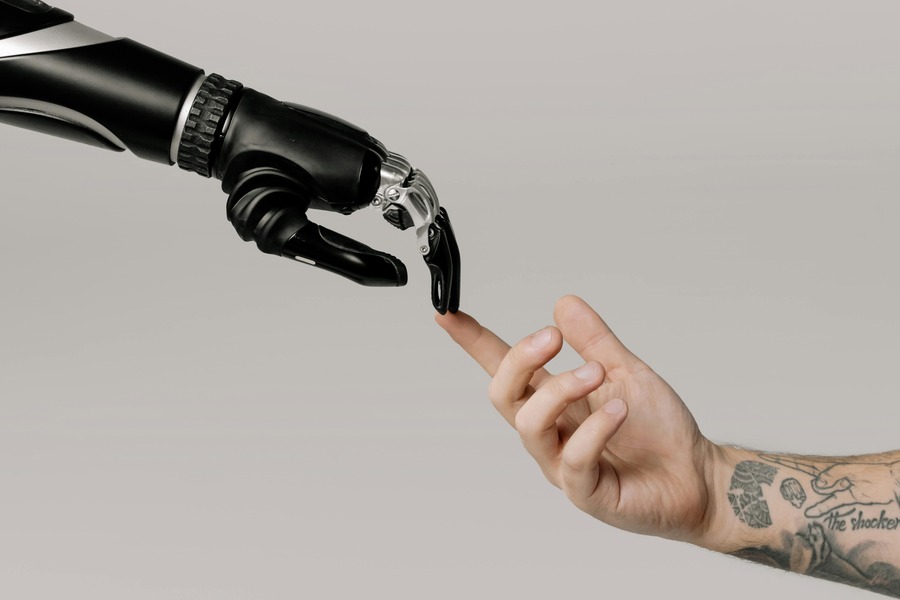AI and Blockchain: A New Era of Technological Innovations

AI and Blockchain: A Powerful Synergy Reshaping Industries
The convergence of Artificial Intelligence (AI) and Blockchain technology represents one of the most potent technological forces emerging today. AI, with its advanced capabilities in learning, pattern recognition, and prediction from vast datasets, finds a powerful partner in blockchain's promise of secure, transparent, and decentralized record-keeping and execution. This synergy allows them to overcome limitations inherent in each standalone technology, unlocking unprecedented levels of efficiency, trust, automation, and innovation across a multitude of sectors. This article explores the complementary nature of AI and blockchain, examines their transformative applications, addresses the significant challenges, and looks towards their increasingly integrated future.
The Complementary Strengths: How AI and Blockchain Enhance Each Other
The true potential arises from combining AI's analytical intelligence with blockchain's verifiable integrity:
Blockchain Enhancing AI
Blockchain addresses critical challenges in AI development and deployment, particularly regarding data trust and operational transparency:
- Secure and Verifiable Data for AI Training: The adage "garbage in, garbage out" is paramount in AI. Blockchain provides an immutable, time-stamped ledger where data sources can be registered and tracked. Using cryptographic hashing, data integrity can be verified before it's fed into AI models, ensuring higher quality inputs and more reliable outputs, which is crucial in fields like medical diagnostics or financial modeling.
- Data Provenance and Algorithmic Auditability: Blockchain can create a transparent audit trail of the data used to train an AI model and the decisions the AI makes over time. This helps address the "black box" problem in AI, making algorithms more accountable and allowing for easier identification and mitigation of potential biases.
- Decentralized Data Control & Marketplaces: Blockchain enables new models for data management. Individuals or organizations can potentially retain control over their data while allowing AI models to access it for training in a privacy-preserving manner (e.g., using techniques facilitated by blockchain). Projects like Ocean Protocol have explored creating decentralized marketplaces for data sharing, governed by blockchain rules.
- Decentralized AI Computation & Governance: Instead of relying solely on centralized cloud providers, blockchain can facilitate distributed networks for AI model training and inference. Techniques like Federated Learning (where models are trained on local data without centralizing it) can leverage blockchain for secure coordination, incentive mechanisms (using tokens), and verifying contributions from different participants. Projects exploring decentralized AI compute (like Akash Network or Golem concepts) aim to democratize access to AI resources.
AI Enhancing Blockchain
AI brings intelligence, efficiency, and predictive power to blockchain networks and applications:
- Smarter Contracts & Automation: AI can significantly enhance Smart Contracts. By analyzing real-time data streams (provided securely by oracles), AI can enable contracts to make more complex, adaptive decisions within their programmed rules. Examples include dynamically adjusting DeFi interest rates based on AI-predicted market conditions, optimizing insurance premium calculations based on real-time risk assessment, or triggering supply chain actions based on predictive analytics. AI can also optimize when contracts execute to minimize Gas Fees.
- Enhanced Network Security & Anomaly Detection: AI algorithms excel at identifying complex patterns that may signify threats missed by traditional security methods. AI can monitor on-chain activity to detect sophisticated fraud attempts, market manipulation, smart contract exploits, or network attacks (like advanced Sybil attacks) in real-time, enabling faster responses.
- Intelligent On-Chain Data Analysis: Blockchains generate massive amounts of public transaction data. AI, particularly machine learning (ML), can analyze this data to uncover trends, predict market movements, assess protocol health, identify influential wallets ("smart money"), and provide actionable insights for traders, investors, and dApp developers.
- Resource Optimization & Efficiency: AI can analyze blockchain network performance, predict periods of high congestion, and potentially optimize block production, transaction ordering (within protocol rules), or resource allocation to improve overall network efficiency and throughput.

Transformative Use Cases Across Industries
The combined power of AI and blockchain is unlocking innovative solutions across numerous sectors:
- Finance (DeFi & Traditional): AI-driven credit scoring for underbanked populations using alternative data verified on-chain; enhanced algorithmic trading strategies leveraging transparent blockchain data; sophisticated fraud detection systems; automated compliance checks via smart contracts; AI-optimized yield farming and liquidity management in DeFi protocols like Aave or MakerDAO concepts.
- Supply Chain Management & Logistics: Blockchain providing an immutable record of goods provenance (e.g., Walmart-IBM Food Trust concept); AI using this trusted data for predictive logistics, demand forecasting, identifying potential disruptions proactively, and optimizing inventory management across complex global supply chains.
- Healthcare: Securely managing sensitive electronic health records on a blockchain with patient-controlled access; AI analyzing anonymized, verified data pools for faster drug discovery, more accurate medical image analysis, and personalized treatment recommendations. Blockchain also aids in verifying pharmaceutical supply chain integrity.
- Energy Sector: Enabling transparent peer-to-peer energy trading on decentralized grids using blockchain (Power Ledger concept); AI optimizing energy distribution, predicting consumption patterns, managing battery storage, and facilitating efficient markets for Renewable Energy Certificates tracked on-chain.
- Creative Industries & Intellectual Property: Utilizing NFTs on blockchain to establish verifiable ownership and provenance of digital/physical creations; AI assisting in content generation (e.g., AI art immediately tokenized) or plagiarism detection; smart contracts automating royalty payments based on blockchain-tracked usage.
- Identity Verification & Security: Building decentralized identity solutions where users control their data via blockchain wallets; AI providing enhanced security through biometric analysis or behavioral pattern recognition linked to verified digital identities.

Navigating the Challenges of Integration
Despite the immense potential, effectively combining AI and blockchain presents significant hurdles:
- Scalability and Performance: Both technologies can be resource-intensive. Processing complex AI models and achieving high transaction throughput on blockchains simultaneously remains a challenge. Layer 2 scaling solutions, off-chain computation, and more efficient consensus mechanisms are crucial areas of development.
- Data Privacy vs. Transparency: Finding the right balance is key. While blockchain offers transparency, AI often requires vast datasets, potentially including sensitive information. Techniques like Zero-Knowledge Proofs (ZKPs) are being actively researched and implemented (ZKML - Zero-Knowledge Machine Learning) to allow computation or verification (like proving AI inference correctness) without revealing the underlying private data. Federated learning also addresses this by keeping raw data local.
- Interoperability: Ensuring seamless communication and data transfer between different blockchain networks and various AI systems/platforms is a major challenge for building complex, cross-functional applications. Standardized protocols are needed.
- Complexity and Expertise: Integrating these two cutting-edge fields requires highly specialized skills in both AI/ML engineering and blockchain development, making talent acquisition difficult.
- Ethical Considerations: Addressing potential biases in AI algorithms (which could be immutably recorded on-chain), ensuring fairness, establishing clear governance frameworks for AI operating via smart contracts or within DAOs, and preventing misuse are critical ethical concerns.
- Regulatory Uncertainty: The legal landscape for both AI and blockchain is still rapidly evolving globally, creating compliance challenges, particularly for applications combining both technologies.
The Future Outlook: Deeper Integration & Intelligent Automation
The synergy between AI and blockchain is set to deepen, driving significant innovation in the coming years:
- Autonomous Systems & DAOs: Expect more sophisticated Decentralized Autonomous Organizations where AI assists in analyzing proposals, managing treasuries, optimizing operations, and even executing certain governance decisions via smart contracts. AI "agents" operating on-chain are a key area of development.
- Intelligent Automation: Complex business processes, from supply chain adjustments to financial derivatives settlement, will become increasingly automated using AI-powered smart contracts operating on trusted blockchain data.
- Enhanced Security: AI-driven threat detection and response systems specifically designed for blockchain environments will become more prevalent and crucial for securing valuable digital assets and protocols.
- Hyper-Personalization with Privacy: Combining AI's analytical power with user-controlled, blockchain-verified data (potentially using ZKPs) could enable highly personalized yet privacy-preserving services across finance, healthcare, and commerce.
- Market Growth: Industry analysts project significant growth in the market for integrated AI and blockchain solutions as businesses recognize their combined value proposition for efficiency, security, and trust.
This powerful combination is integral to many visions of The Future of Crypto and Web3.
Conclusion: A Transformative Partnership Powering the Future
Artificial Intelligence and Blockchain technology are individually transformative, but their true disruptive potential is unlocked when they converge. Blockchain provides the secure, transparent, and decentralized foundation that can enhance trust and integrity in AI systems. AI, in turn, brings the intelligence, automation, and predictive capabilities needed to make blockchain applications more efficient, adaptive, and powerful.
While significant technical, ethical, and regulatory challenges must be navigated, the synergy between AI and blockchain offers compelling solutions for industries grappling with issues of data security, operational efficiency, transparency, and trust. Their continued integration promises to be a major driving force behind the next wave of technological innovation, creating smarter, more secure, and more automated systems that will reshape business and society.







